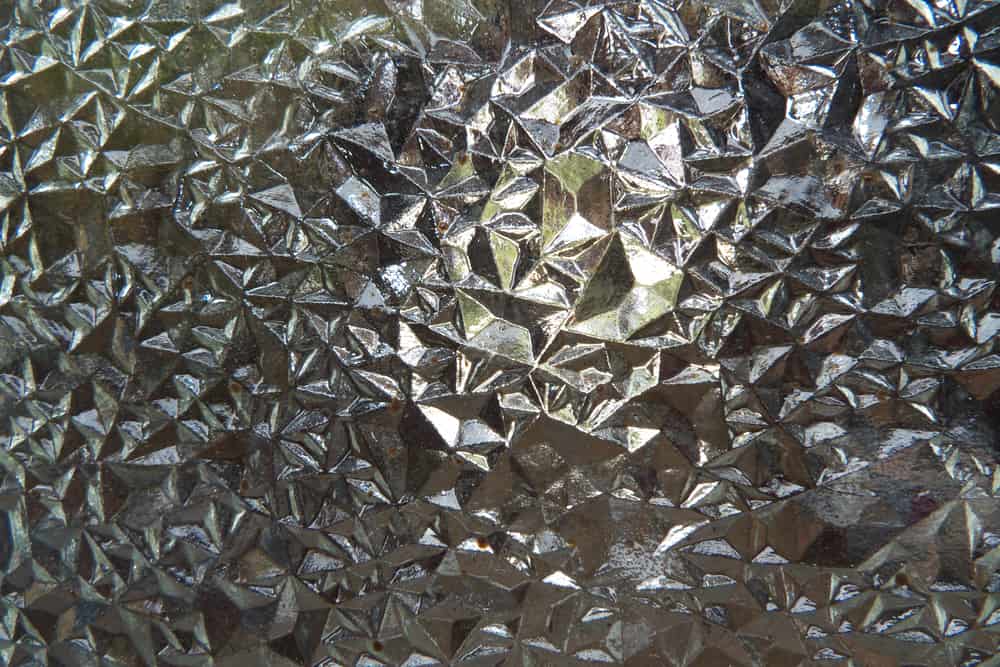Since its inception, glass has been tied to man, serving as both a functional element and a decorative and artistic object.
Glass, along with ceramics, is the oldest and most widely used material for product preservation and storage due to its unique properties.
In this article, we’ll delve into the skill of identifying antique glass marks and provide you with a comprehensive overview of the vast and interesting world of antique glass.
Table of Contents
History of Glass
Glass is a naturally occurring element. Volcanic lava with a high silica content cools rapidly to form obsidian.
The oldest record we have dates back to 12,500 B.C. in the region of what is now Kurdistan.
The earliest glass specimens date back to 2500 BC, found in Egyptian tombs on the shores of what is now Lebanon.
Already for the year, 1500 B.C. pots produced with this material can be found. Asian artisans likely brought the art of glass making to Egyptian lands.
At first, the glass was not transparent, but natural greenish color. Then they learned to give it colors and tried to imitate certain precious stones with its manufacture.
Then in the 1st century B.C. The technique of blown glass was discovered on the Phoenician coasts, which made it much easier to make it and was one of the main reasons why it became known worldwide.
Then the Romans spread it throughout their empire and it was during this time that it was discovered that glass could be made clearer by adding magnesium oxide.
Throughout the Middle Ages, glass continued to be used utilitarianly in Europe and was adopted with great acceptance in Islamic countries from the 8th to the 14th century.
During the Renaissance, Venetian glass achieved great popularity until the end of the 17th century when new methods of glassmaking were discovered in Germany and England.
During the Venetian heyday, they made a hard and refined glass which they called “Cristallo”. Even though there was a law that prohibited Venetian artisans from leaving Venice to safeguard the secrets of how they made glass, over time their techniques spread throughout Europe, achieving imitations of equal quality.
At the turn of the 18th century, the French Enlightenment bolstered the Bourbons’ desire for glass, promoting the development of the glass industry in France and Spain.
For centuries, glass fusion was an artisan task that was modernized and mechanized during the Industrial Revolution. Fusion systems were improved at the end of the 18th century and, in particular, throughout the 19th century, and new fuels with higher calorific value were introduced.
The use of coal enabled advancements in infusion systems and the production of higher-quality glass. Later, in the first half of the twentieth century, these fuels would be gradually replaced by oil, and the great industrial leap in container manufacturing would be developed through complete mechanization of the process and large-scale manufacturing.
In the first decades of the twentieth century, the prestige of colorless and exquisitely transparent lead crystals, generally decorated with engraved drawings, grew as a result of the artistic currents of Art Nouveau and Modernism.
In the 1960s, American artist Harvey Littleton and industrial scientist Dominick Labino launched a new era in glassmaking. Both began experimenting with blown glass as an artistic medium in small ovens installed in their studios, and have since become two references in the artistic and stylistic domain of glass until the present day.
Types of Antique Glassware
Knowing the most common varieties of glassware available is one of the first steps toward becoming an expert in spotting marks on glass pieces.
Milk Glass
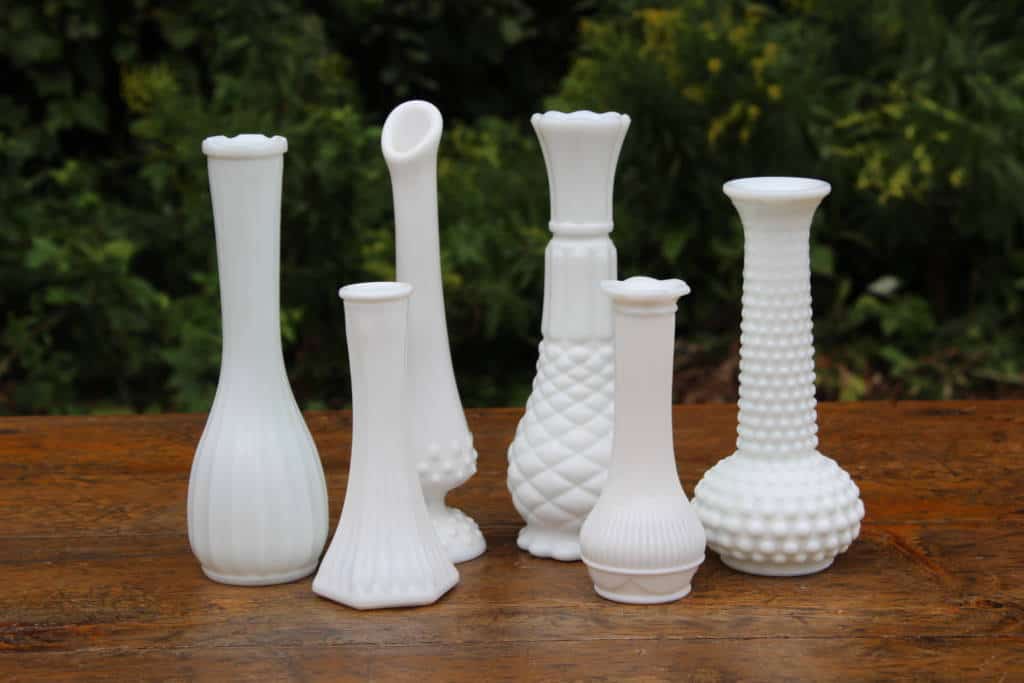
The most prized milk glassware is antique milk glasses. They were quite popular in the nineteenth century and into the twentieth century.
Most people believe they were only available in white, although they were actually made in a variety of colors.
The majority of these items were made in the United States by businesses including Westmoreland and Atterbury & Company, Fenton, and Kemple.
Kitchen Glassware
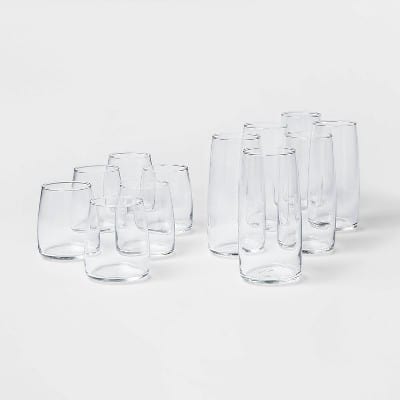
Because it was inexpensive to create during the Great Depression, this form of glassware became highly popular. It was used to make cooking utensils, as its name suggests.
Platonite, Jadeite, Fire King, and Delphite are among the materials utilized in this form of glassware. Jeanette Bottle Works was one of the most well-known producers who worked with these materials and produced a series in an industrial setting.
Products created from these materials are fairly inexpensive, with many items costing between $10 and $20. However, there are some extremely rare items that can cost hundreds of dollars.
Elegant Glass
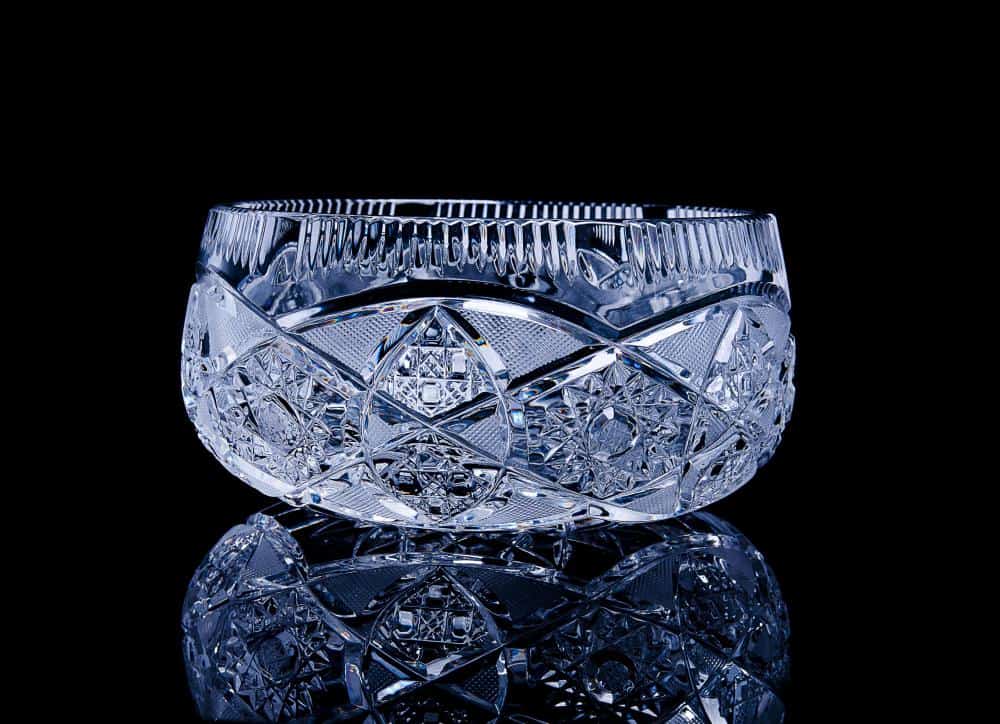
During the Great Depression, even though most manufacturers switched to kitchen glassware, which was cheaper and easier to make, Elegant Glassware focused on producing high-quality items.
It caters to a more affluent clientele, thus its products are one-of-a-kind, with sophisticated and elaborate designs, as well as a wide range of designs and colors.
Its creation was more difficult, and it required the use of talented artisans who could not only manufacture high-quality items but also be inventive in their design and execution. As a result, prices were relatively costly, and only a small audience could afford them.
The date of manufacture determines the worth of this sort of glassware. When praising them, their patterns and colors are also crucial. Depending on the collection, they can be worth thousands of dollars.
The companies that stood out for making this high-end glassware were Imperial Glass Corporation, Fostoria Glass Company, and Cambridge Glass Company.
Depression Glassware
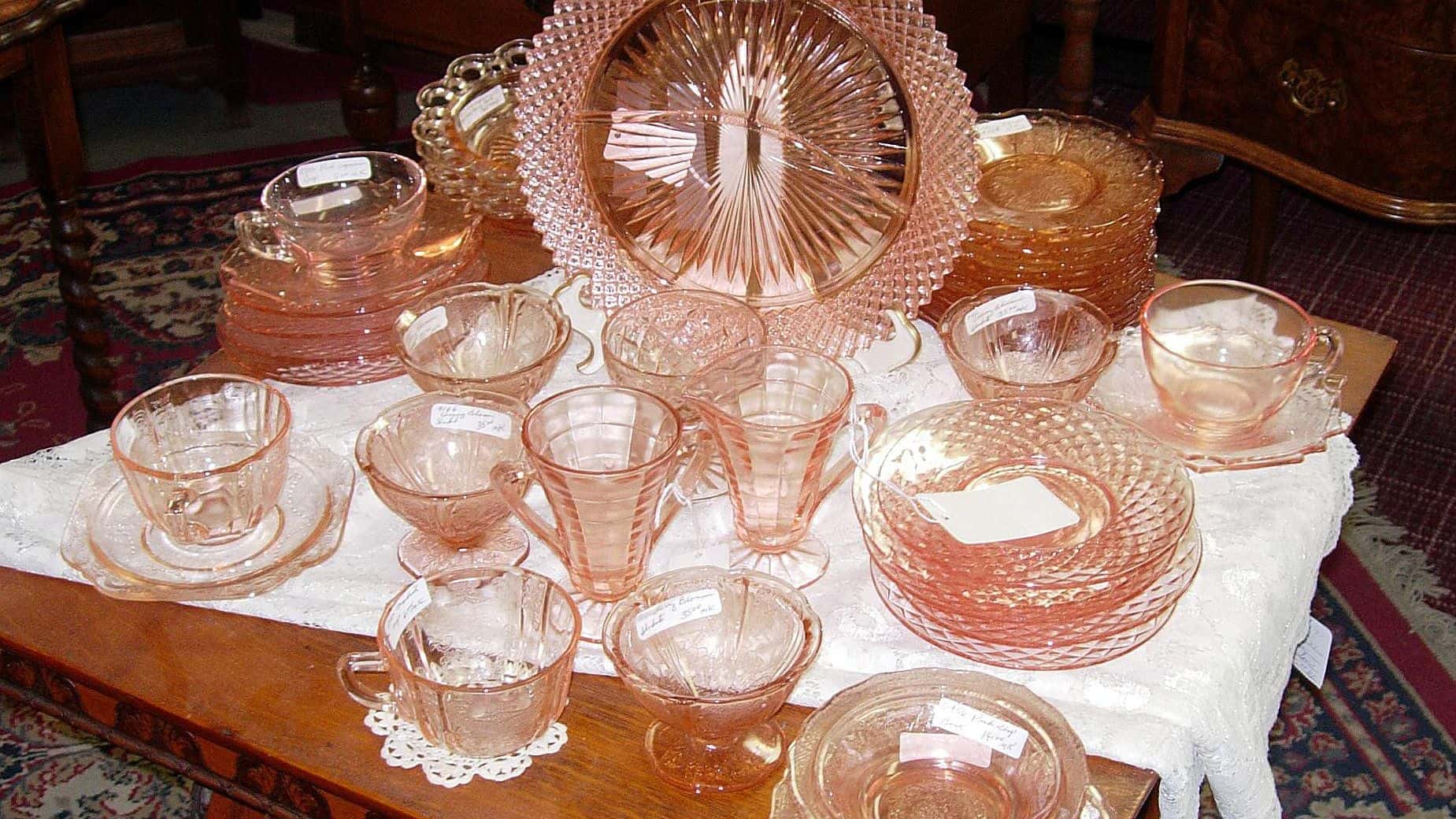
The geometric designs and engravings on this glassware set it apart. The design, color, and overall condition of the item determine its cost. The most popular and valuable pieces are the green and pink ones and Jeannette Glass Company made the best pieces in this style.
Crystal Glassware
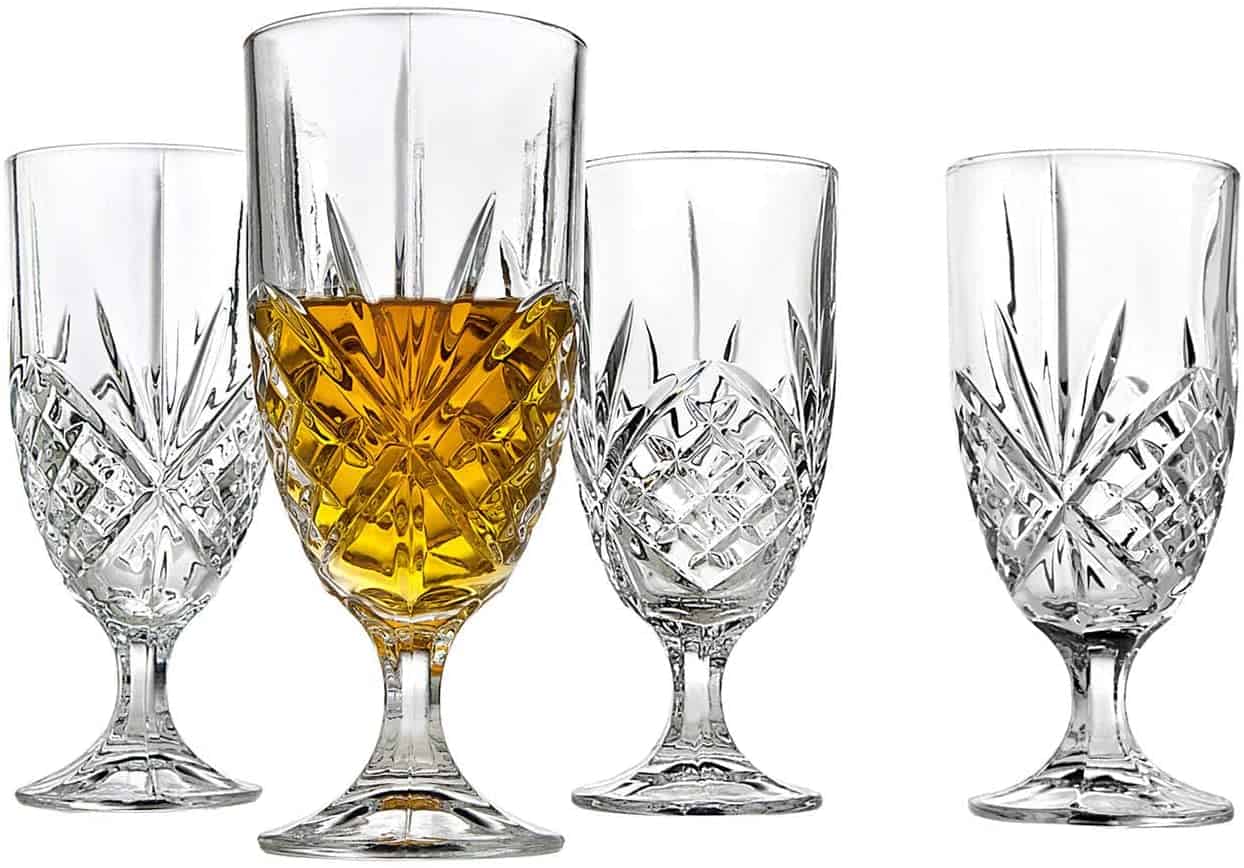
One of the distinguishing features of this glassware is the presence of lead. This material makes it more durable than regular glass.
The appearance of this type of glassware is the easiest way to identify it, as it reflects light with great power and produces a very distinctive colored prism. The sound is also important because striking it produces a sharp sound.
From the nineteenth century to the 1920s, it was extremely popular.
Prices vary greatly depending on the manufacturer, but pieces made during the American Brillant period are the most expensive.
Carnival Glass
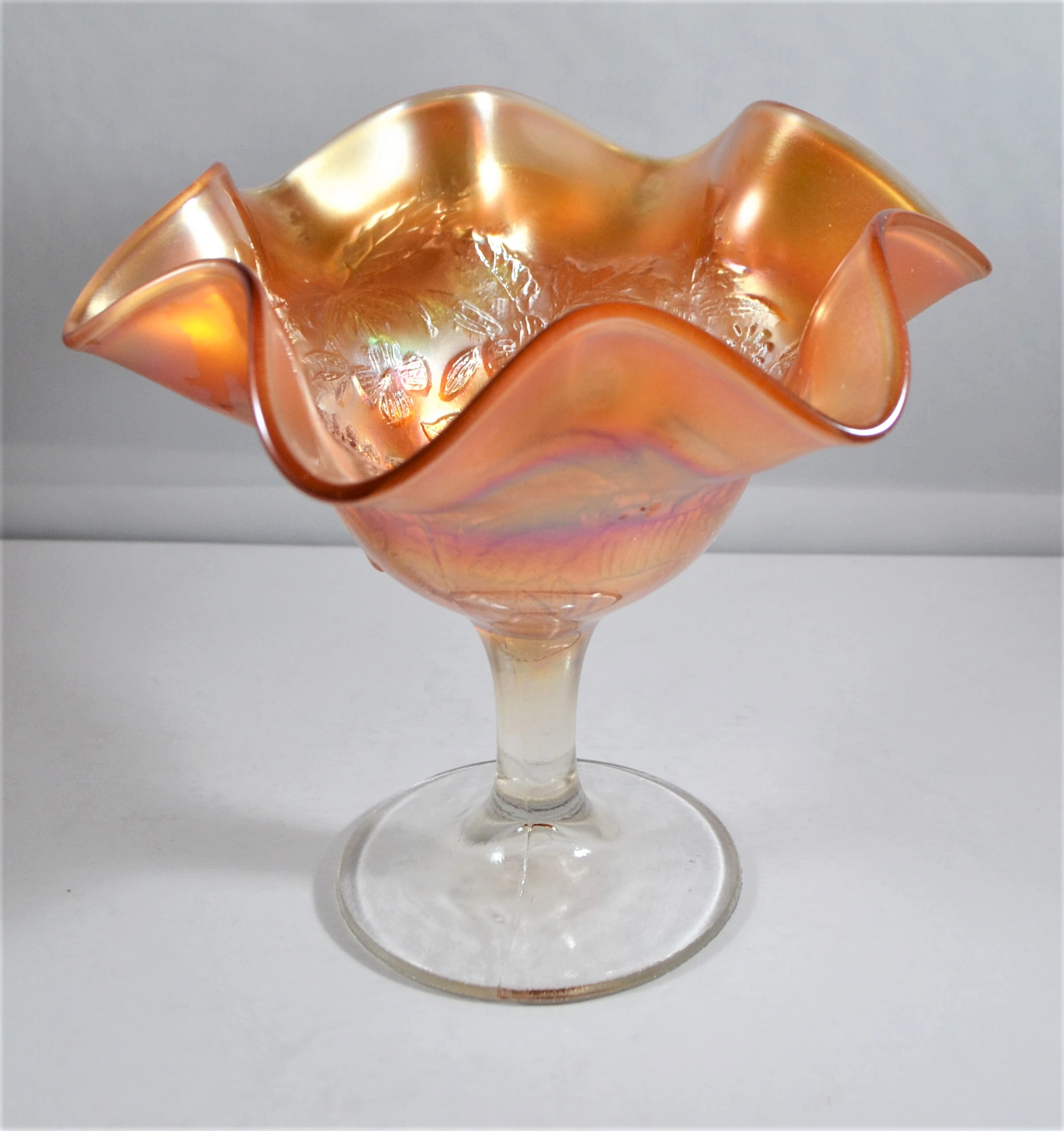
Tiffany’s Favrile glass was the market leader among a wealthy economic sector at the turn of the twentieth century. However, the Fenton Glass Company desired a less expensive option in order to expand the market. However, the price remained high, and customers preferred to pay a little more for an already well-known and prestigious brand rather than something with less status.
Carnival glass quickly became obsolete, and no one was buying it in less than 20 years. They didn’t become fashionable again until the 1950s, thanks to their decorative qualities.
It stands out because its brightness changes color depending on the angle at which it is viewed. All parts manufactured before the 1940s are extremely valuable. The marigold and green pieces, in particular, are worth thousands of dollars.
Art Glass
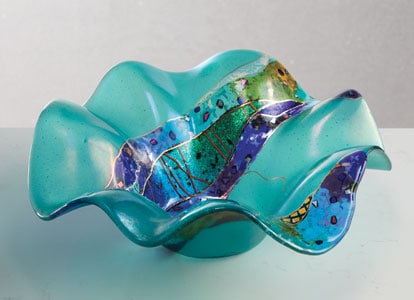
This style emerged at the beginning of the twentieth century as a result of the need for artists to create one-of-a-kind pieces. It is notable for its incredible color palette and for being inspired by nature.
The majority of the designs are by skilled artists, and the bowls, vases, and bottles are almost always signed.
They regained popularity in the 1950s and 1960s. Keep in mind that they are one of the most difficult pieces to correctly identify and value. To do it well, you must have a thorough understanding of the style, colors, and original marks.
Typical Markings on Antique Glass
Knowing the most common varieties on a piece of antique glass is one of the first steps toward becoming an expert in spotting marks on glass pieces.
There are logos, symbols, signatures, and trademarks. It can also be the case of a combination, such as a trademark accompanied by the logo.
Keep in mind that many pieces of glass will not have any identification marks, and in these cases, other criteria will be used to determine whether the piece of glass in front of you is valuable or not, but many pieces do have marks and will be very useful in determining whether the piece of glass in front of you is valuable or not.
The majority of these marks can be found on the bottom of the glass. However, it is not the only place to look, as the mark can also be found on the sides.
Keep in mind that having a magnifying glass and a portable light handy while identifying a brand is a good idea, because brands fade over time, making it difficult to recognize them correctly. As a result, the more assistance you have, the better.
Look for these Other Markings and Tips to Identify Antique Glass
What if none of the above marks are available?
Don’t panic; you still have a few tactics up the sleeve that can help you figure out some clues on how much the piece of glass is worth and how old it is.
Search for pontil marks. The pontil is the instrument with which glass is blown and you can usually find in old glassware the mark left by the pontils when making the pieces. They are all in the lower part of the piece, which is the part that you support so that they can stand up.
Another mark to watch is the one left by the mold in which the piece was made. Keep in mind that pieces made in the same mold will have the same flaws or traces.
Inspect inside the glass for marks such as air bubbles. In this manner, you can tell how the glass was formed and get a rough estimate of the year it was made based on the process utilized.
Always try to determine the age of an item by inspecting the bottom for evidence of wear or scars, cracks, chips, or scratches. A golden color also suggests that the item has been used extensively.
It’s also important to note that many items from the middle of the nineteenth century contain a registration mark. This mark usually consists of registration numbers that reflect the decade in which it was created.
Another sort of marking that corporations used to label their parts was acid badges.
Other pieces include diamond marks to signify that the company or manufacturer’s design has been registered.
Remember that engraved signatures are typically hidden and difficult to find, but if located, they can provide valuable information about the piece’s legitimacy.
Cut glass signatures were popular as well, and they frequently indicate that a piece was manufactured in the early twentieth century.
Another helpful tip is to remember that the numbers on the glass stoppers correspond to the numbers on the bottom of the bottle. They must always match. When scrutinizing jars or perfume bottles, this is quite beneficial.
These marks are fairly common on the neck of the bottle and the pin of the cap.
How to Find Antique Glassware Values
Any collector needs to know how much a piece of vintage glassware is worth. These are some resources where you might find detailed information.
Guide to Antique Glassware
Antique glassware guides are required reading for any serious collector. These manuals will provide you with all of the information you require about the manufacturers, so you should always examine and study them.
Remember that the world of glassware is vast, and mastering the art of identifying items takes years of practice. Even the most seasoned collectors may come upon previously unknown rarities.
- American Slag Glass: Identification and Values
- Collectibles Guide 2013
- Art Glass: Identification & Price Guide
- Collectibles Price Guide
- Carnival Glass: The Best of the Best: Identification Guide to Rare and Unusual Pieces
Online resources
In the area of the internet we not only have books and guides, but we also have a wide source of information through online resources. These resources will definitely broaden your knowledge and are easier to access than books and guides.
Is it possible to detect vintage glassware with an app?
CamFind is an alternate version of the Image Searcher app. The developers are the same, but CamFind is designed to work with Google Glass. Just download the app and add it to your Google Glass for CamFind to recognize it in seconds. This can be a very useful tool when it comes to recognizing old glassware.
Tips on cleaning antique glassware
The main key is to know what kind of glass you have in your hands, since that way you will know which method is convenient for you to use. You will most likely always need a long brush to clean the inside of bottles and a soft cloth for glass with decorations when using abrasives.
Always choose the least aggressive method to clean glassware, then level up as the piece needs it.
If you can’t tell if your piece is getting clean with the method and product you use, let it dry, and then check if you’re on the right track.
As you may have guessed, the world of antique glassware is vast, and becoming an expert requires substantial research.
We hope that this guide has given you a better understanding of the fascinating world of antique glass pieces and how to identify their brands and characteristics. Always remember to keep researching and learning, since this is the key to success when it comes to antique glassware.
